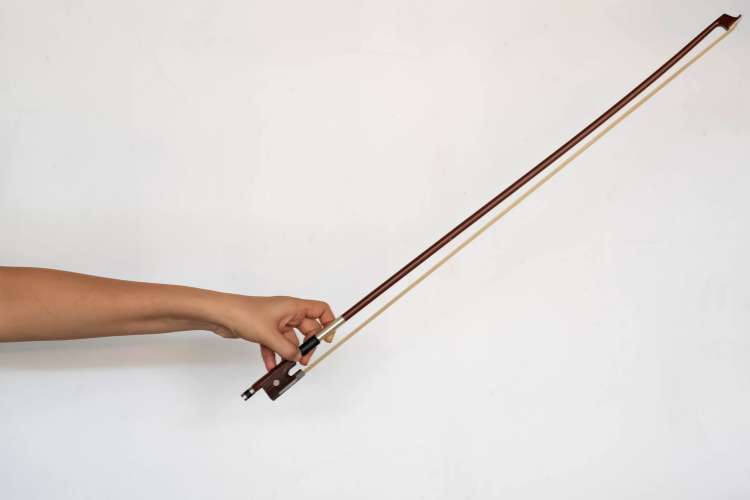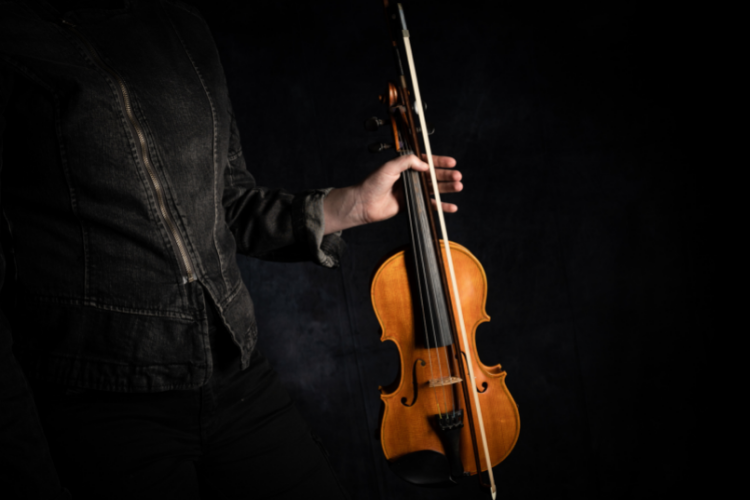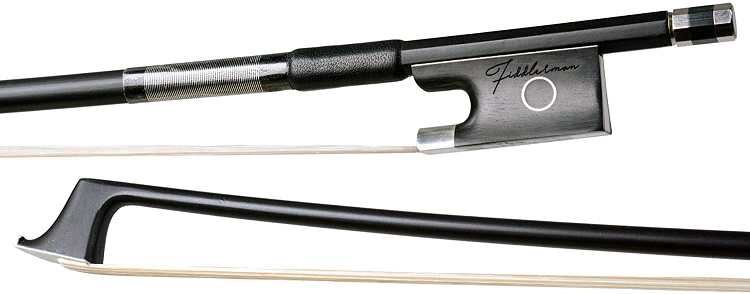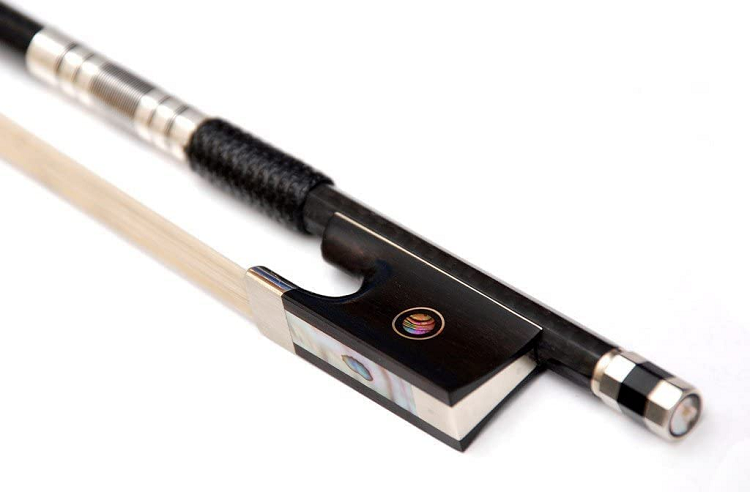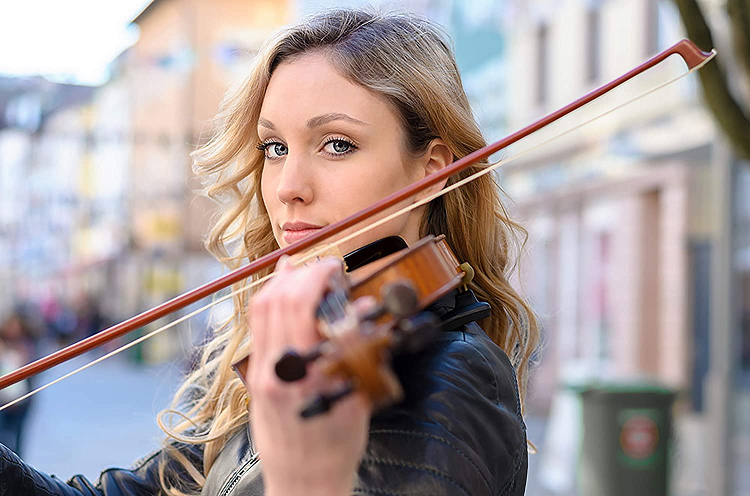- How to Find the Best 5 String Violins - April 21, 2022
- How to Hold a Violin Bow - April 21, 2022
- How to Hold a Cello Bow - April 17, 2022
Summary: Learning how to hold a violin bow will help you improve your technique and make playing easier.
Learning how to hold a violin bow is one of the first steps when you get a violin. While picking the right violin is essential, choosing the right bow and learning how to use it helps develop the proper technique.
How to Hold a Violin Bow: The Five Parts
Before I dive into instructions on how to hold a violin bow, you need to know the five main parts of a bow. These parts are the same for all stringed instruments, and knowing their name/materials helps you identify where to put your fingers when you play.
A violin bow has a wooden stick and hair that rubs along your strings. As the hair goes back and forth, it creates vibrations converted into sound. Your violin bow’s design is slightly different from a viola, cello, or bass when it comes to the number of hairs used, the length, and the wait but otherwise functions in the same way.
Bow Stick
The bow stick is the physical stick that runs the length of the violin. This is commonly made of wood or carbon fiber.
Bow Hair
The hair is usually horsehair. It is what comes into contact with your violin strings. It is also parallel to the bow stick.
Tip
The tip is the top edge of the bow. Here is where your bow hair connects to the bow stick. This is also the top part that gets played against the strings.
Frog
The frog is usually made of wood and attaches to the handle. This is the opposite end where the bow hair attaches to the bow stick.
Grip/Pad
The grip or pad is located near the base of your bow stick. This is where you hold it, so it is usually covered with rubber or leather.
A straight bow stick with lots of hair is excellent for a beginner. The more hair you have, the easier it will be to generate sound and learn how to hold a violin bow and control it properly. As you get better, you might invest in slightly curved violin bows with less hair to make the most out of the refined techniques you have.
Materials
The stick is usually made from one of three materials:
- Brazilwood
- Pernambuco
- Carbon fiber
Brazilwood is not one type of tree but rather a hardwood from Brazil. This is often reserved for beginners.
Pernambuco also comes from Brazil, but it is heavier and denser. This is usually for professionals because it has more variability in its strength and elasticity.
Carbon fiber is a newer material used with grades of carbon fiber bonded through the resin. You might even find combinations of Pernambuco and carbon fiber. This is suitable for intermediates or professionals. Even beginners can invest in a stick material like this, knowing they will grow into it.
Size
The size of your violin will directly correlate to the bow size you get. If you have a fractional violin, like ½, aim for a ½ size bow to match.
Shape
Most bow makers give you round bows, but you can invest in octagonal bows too. The more experienced you are, the more things like multidimensional sounds from two materials matter. As a beginner just learning how to hold a violin bow, you can stick with a beginner model that is stiff and made with one type of material.
How to Hold a Violin Bow
When you pick up your violin bow, no matter the material or shape, how you hold it is precisely the same.
- Start by turning your fingers so that they make a round shape. You want to curve your middle finger, ring finger, and thumb. The tip of your thumb should be pressed against your middle finger and ring finger.
- Then you curve your pinky and index finger to raise slightly and relax your hand.
- Place your thumb between the bow hair and the stick right next to the frog with a curved thumb.
- Allow your ring finger and middle finger to drop into place naturally. Your middle finger should rest opposite your thumb with your ring finger right next to the middle finger.
- Let your pinky rest in a curved position but away from your ring finger.
- Finally, relax your index finger and let it fall onto your bow stick, slightly curved and facing the other fingers. Your index finger will typically sit on the leather part of your stick so that you can grip the violin bow while you play.
It’s easy for a beginner to hold tension and think that we need to keep stiff claw fingers when we don’t. Let your hand relax with all of your fingers in the correct position. When you have the proper grip, press down on the violin bow with the tip of your pinky. If your violin bow is still held in your hand and the bow goes up, you have the perfect technique. Now all you need to do is practice.
Mistakes to Avoid
If you are a beginner, it’s totally acceptable to encounter some common mistakes.
- If you practice holding your violin bow and your hand is still painful after each practice, try to keep your palm and your wrist relaxed. Keeping them stiff while you practice can cause the rest of your hand to feel sore at the end of a rehearsal.
- If you have problems holding your bow while you are playing, don’t stress too much. It will take time for your hands to adapt to holding a bow. Usually, when you play, downstrokes will keep your fingers curved, and upstrokes will elongate your fingers. Keep your wrist in a neutral position where it is relaxed. It’s easy to bend your wrist and try to compensate when your hand isn’t accustomed to the feeling of holding a bow but avoid that. You don’t want to develop bad habits.
- If you are creating scratchy sounds when you move your bow, you probably aren’t keeping good contact with the strings or holding your bow straight across the strings as you go. So practice maintaining perfect contact all the way through.
Why Violin Bows Matter
Different violin bows produce different sounds when used on the same instrument. If you are a beginner, this won’t matter as much because you won’t have a trained ear, so that you won’t hear the differences.
However, as you advance in your skill, you’ll be able to hear subtle differences that come from different violin bows. Even if you can’t hear them, rest assured that your audience can.
- A bow with too much bend in the wood won’t give good clarity.
- A stiff and strong bow will give a fuller, smoother sound.
- Stiff, strong bows give a brighter, more focused sound.
- Bows that are too stiff sound edge and rough
It’s essential that you find a bow with the right stiffness and strength level without too much. Think of finding your violin bows like Goldilocks finding the perfect bowl of porridge or bed. You want something that’s not too far in either direction.
You also have to consider what musical genre you are playing. If you are a more advanced player and you use your violin for jazz, you might need a brighter sound, whereas someone who only performs classical music won’t.
This short video explains how violin bows are made and what the materials look like: https://www.youtube.com/watch?v=LFj1ZkuuFKo
Where to Get a Violin Bow
If you purchase a beginner violin and you are brand-new, or you are purchasing for a child in your family who is brand-new, you likely got a bow with your instrument package.
Most beginner instruments from student brands like Cecilio, Mendini, and Kennedy Violins give you the accessories you need to get started, including a bow.
If you are lucky, the bow will be made of Brazilwood with unbleached Mongolian horsehair. However, you are not stuck with the bow that came with your package.
It can be great to practice with this and get the hang of how to hold a violin bow but once you figure that out and start to refine your technique, consider investing in something a little more high quality.
How to Hold a Violin Bow: Selection Criteria
Now that you understand how to hold a violin bow, it’s essential to evaluate different bows and which one you might prefer When developing your technique further. To help you with that, I have put together a quick selection of some top violin bows based on their performance, design, material used, and suitability for different musical skills.
How to Hold a Violin Bow: What Bow to Buy
Fiddlerman Carbon Fiber Violin Bow 4/4
This option comes with four sizes, so you get a great deal more flexibility if you work with a fractional-sized violin. Fiddlerman is a highly-regarded manufacturer of stringed instruments and their accessories. You get an excellent arch with good action and bounce. The ebony frog is copper mounted, and the Siberian horse hair is genuinely stunning. It weighs very little because it is carbon fiber, and you get a superior resonance with a lightly crafted violin bow.
Pros
- It comes in four sizes
- Made with carbon fiber and ebony
- Uses quality Siberian horsehair
- Has great balance
Cons
- One of the more expensive options
Violin Bow 4/4 Carbon Fiber Bow Advance Horse Hair Pernambuco Level
This particular model is made with carbon fiber and pernambuco wood. The company does make cheaper brazilwood models, but this is something you need as an intermediate player.
It arrives in its own case and is perfect for the violin or the fiddle. You get an ebony frog with white, unbleached Mongolian horsehair, which is juxtaposed beautifully with the black color of the bow stick. The carbon fiber is handcrafted and very lightweight. It’s solid and stiff, so you get good balance and responsiveness.
Pros
- This is carbon fiber with Pernambuco, so it has two of the more superior materials combined
- It uses Mongolian horsehair
- You get an individual case for storage
Cons
- It is only available in full size if you want carbon fiber
ADM 4/4 Full-Size Student Violin Bow
This is a great model for beginners. It’s well-balanced with quick responses, perfect for students. The thumb grip is crafted out of synthetic leather, so it has a classy appearance and a good feeling underneath your fingertips.
You get nickel silver winding with a nickel silver mount. The bow weighs very little, and it’s an excellent product for beginners who just need something they can use to practice as they learn how to hold a violin bow.
Pros
- This is an inexpensive model
- You can find a full size or half size
- It has unbleached Mongolian horsehair
- It comes with Brazilwood for the stick
Cons
- This is student grade, so it doesn’t work well for intermediate or advanced students
FAQs
Answer: While the playing technique might be similar, a viola bow and a violin bow have different shapes, lengths, and weights. A viola bow is taller than a violin bow, and it usually has a square heel, whereas a violin bow has around here. If you try to use the wrong bow, you won’t develop the proper technique, and it won’t give you the sound you want.
Answer: The average violin bow should weigh around 60 grams.
Answer: The cost for violin bows will vary based on the materials used. Suppose you are a beginner and you just need to learn how to hold a violin bow and use it on your instrument. In that case, beginner models might be included with your purchase of a violin, or they might cost around $15 or $20 for beginner brazilwood models.
Bottomline
Learning how to hold a violin bow might take you a few rehearsals, but it becomes second nature once you figure it out. What’s most important is having a good bow and developing the proper technique straight from the beginning; otherwise, it will take you longer to break old habits to hold your bow the right way.
Looking for more interesting readings? Check out:


